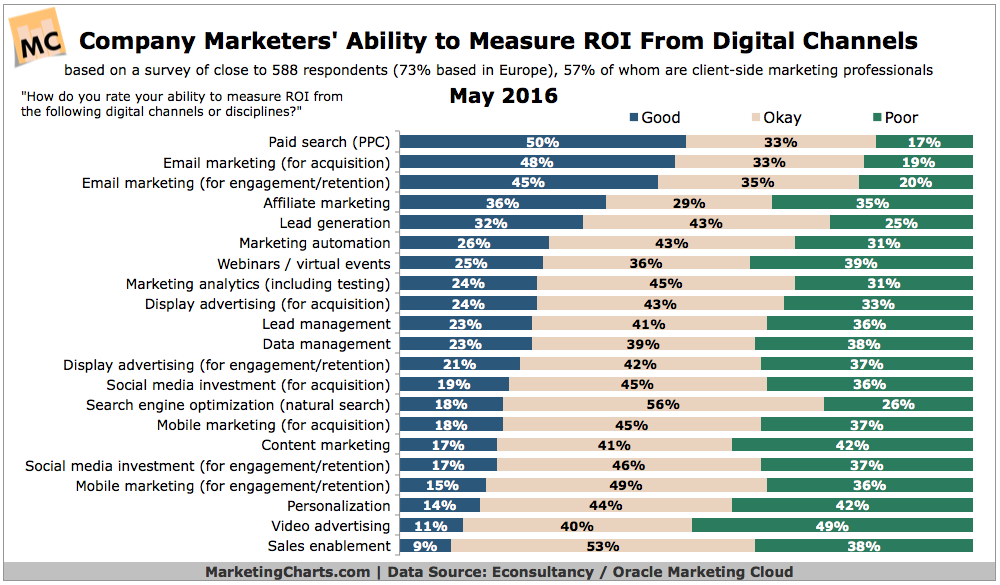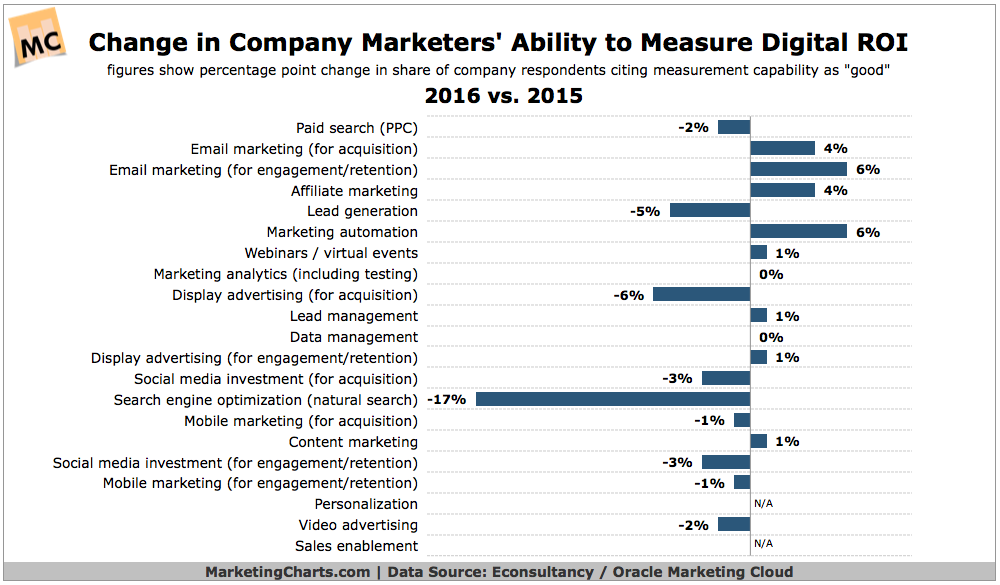A new report released by eConsultancy, in collaboration with Oracle Marketing Cloud, has revealed precisely which channels marketers feel deliver the biggest impacts on their return on investment, and how they bring those priorities to light within their respective teams and companies.
If your efforts to squeeze relevance out of marketing initiatives leaves you feeling frustrated and confused – it turns out you are not alone. So which channels were the most worthwhile, and what efforts should you be investing more time and money into? Let’s take a closer look:
The Big ROI Catch-22
Not surprisingly, the report noted that the biggest roadblock to bigger investments in digital marketing was, simply, budget constraints. Staff constraints followed second, as did company culture and an inability to measure ROI. The report itself asked the question, “Is the culture of ROI stifling innovation?”
This creates an interesting catch-22 in that if you cannot accurately measure your ROI, you can’t provide the proof management wants. And without proof, you don’t get an increased budget to work with. So which channels deliver the kind of proof you need? Here are the results:
Marketing With Confidence
Marketers rate their confidence in measuring ROI from different types of digital channels
Looking carefully at this chart, you’ll see why there’s such a disconnect between marketing investment and marketing results: paid search was the only channel where at least 50% of respondents noted that they felt “good” about ROI measurement. Other channels, including email marketing for acquisition, and email marketing for engagement and retention came close, but as the report notes, only a handful of companies would rate their confidence as “good” in these areas.
Note the considerable drop-off after this point – automation, analytics, even content marketing takes a notable hit here.
What’s Causing the Drop?
As much as we embrace and encourage the use of many of these marketing channels, it’s clear that marketers are struggling to take the information they collect and turn it into actionable insights that have marked results in their campaigns. According to the report, there are three main factors contributing to such a steep decline in measuring ROI confidence:
Budget Plans
If you’re thinking budget woes stem from a tight squeeze on marketing spending (on account of a lack of provable, measurable results), that’s not quite the whole picture. Nearly 75% of respondents on both the client and supply sides expected their digital marketing technology spending to increase.
However, a little over half of those same respondents acknowledged that it was easier to get executive buy-in and support to increase those budgets. This means there’s still quite a bit of work to do to convince the board room that these efforts are simply stepping stones toward the bigger picture of measurable results that they’re seeking.
The Customer Experience
There’s a lot of talk in marketing circles about “the customer experience” – but just how much of an impact does it have on spending? As it turns out – a lot. Making sure the customer experience is seamless across all channels is an area of significant focus for marketing, sales and customer service teams alike, and having consistent, measurable results are at the core of marketing technology investments.
Because so much is being funneled into measuring and realizing the customer experience, precious little of the budget can be afforded to try more innovative and untested strategies. More money is going toward acquisition efforts than engagement and retention, although as other studies have shown, this may very well be an exercise in focusing too much on quantity versus quality.
Company Culture and a Focus on ROI
And with so much of a focus on only measurable strategies with quantifiable results, innovation is hurting as well. Only 35% of those surveyed agreed that they reserved a portion of their marketing budgets for more maverick, untested strategies – a sharp downturn from the 46-37% range from previous few years.
That being said, budgets are increasing not only in customer acquisition and lead generation, but also in other areas as well – namely email engagement and retention, acquisition over social media and data management.
And speaking of year-to-year differences, if you think they don’t matter much in the long term – I have some surprising news. There were quite a few significant changes from 2015’s ROI confidence metrics compared to now:
What a Difference a Year Makes
Marketers had a very different view of ROI confidence among specific channels in 2015
Look at the marked decrease in organic SEO. With paid search as one of the consistent ROI confidence forerunners, it makes sense that natural search is slipping. Considering that search engine algorithms and updates become more and more complex, creating tools and platforms to accurately measure them has become harder and harder.
But also note the increases in areas such as email marketing, affiliate marketing and automation. Our tools for measuring the “people side” (as opposed to the algorithm side) of things are becoming more intuitive. The focus goes back to the customer experience, coming full circle in giving managers and other top level executives the measurability they crave while investing in a marketing plan built for consumers, not robots.
Moving Forward with Confidence
With all this talk of marketing investment, return-in-investment, budget buy-in and confidence, you could say that a great deal of stress in trying to “prove” the best outlets for spending is putting increased pressure on today’s marketing teams. That being said, however, our focus is shifting more toward measurable results as they relate to people, not programs – paving the way for more insightful tools that help us unlock a bit more of buyer behavior as we continue to map the customer journey.
But as marketers reading about marketing spending and measurement, we’d like to hear what you think. In your own experience, have you found the findings noted here to be true for your own work? Or do you feel that the end goal as to what constitutes “measurable” is constantly being moved? We’d love to hear your feedback and thoughts, so why not share with us in the comments below?
About the Author: Sherice Jacob helps business owners improve website design and increase conversion rates through compelling copywriting, user-friendly design and smart analytics analysis. Learn more at iElectrify.com and download your free web copy tune-up and conversion checklist today!



Comments (6)